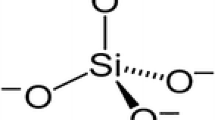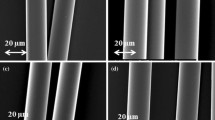Abstract
New bioactive phosphate glasses suitable for continuous fibre production are investigated in this work. The structure of both bulk and fibres from Na2O–CaO–MgO–P2O5 glasses has been studied by means of Raman and 31P and 23Na nuclear magnetic resonance spectroscopies, and the structural results have been correlated with the mechanical properties of the fibres and the dissolution rate of the bulk glasses. It has been observed that the mechanical properties of the phosphate glass fibres are influenced by the glass network connectivity, while the dissolution rates are governed by the Q i speciation of the PO4 units. As seen in previous studies, molar volume seems to play an important role in the fragility behaviour of phosphate glasses. Here, a lower molar volume resulting from the increase in the oxygen packing density hinders the cooperative flow of the PO4 units throughout the glass network and, therefore, causes a reduction in the kinetic fragility.


Note Q 1 point in glass fibre x = 10 and x = 20 is not observed due to the overlap with other points

Note Eq. (8) is only applied for glasses containing 50 mol% or less of P2O5






Similar content being viewed by others
References
Hench LL, Hench JW, Greenspan DC (2004) Bioglass: a short history and bibliography. J Australas Ceram Soc 40(1):1–42
Knowles JC (2003) Phosphate based glasses for biomedical applications. J Mater Chem 13:2395–2401
Parsons AJ, Ahmed I, Haque P, Fitzpatrick B, Niazi MIK, Walker GS, Rudd CD (2009) Phosphate glass fibre composites for bone repair. J Bionic Eng 6:318–323
Brauer DS, Rüssel C, Vogt S, Weisser J, Schnabelrauch M (2008) Degradable phosphate glass fibre reinforced polymer matrices: mechanical properties and cell response. J Mater Sci Mater Med 19:121–127
Bunker BC (1984) Phosphate glass dissolution in aqueous solutions. J Non-Cryst Solids 64(3):291–316
Haque P, Ahmed I, Parsons AJ, Felfel R, Walker GS, Rudd CD (2013) Degradation properties and microstructural analysis of 40P2O5–24MgO–16CaO–16Na2O–4Fe2O3 phosphate glass fibres. J Non-Cryst Solids 375:99–109
Massera J, Ahmed I, Petit L, Aallos V, Hupa L (2014) Phosphate-based glass fiber vs. bulk glass: change in fiber optical response to probe in vitro glass reactivity. Mater Sci Eng C 37:251–257
Massera J, Vassallo-Breillot M, Törngren B, Glorieux B, Hupa L (2014) Effect of CeO2 doping on thermal, optical structural and in vitro properties of a phosphate based bioactive glass. J Non-Cryst Solids 402:28–35
Brauer DS, Karpukhina N, Law RV, Hill RG (2010) Effect of TiO2 addition on structure, solubility and crystallisation of phosphate invert glasses for biomedical applications. J Non-Cryst Solids 356:2626–2633
Döhler F, Groh D, Chiba S, Bierlich J, Kobelke J, Brauer DS (2015) Bioactive glasses with improved processing. Part 2. Viscosity and fibre drawing. J Non-Cryst Solids 432:130–136
Parsons AJ, Sharmin N, Shaharuddin SIS, Marshall M (2015) Viscosity profiles of phosphate glasses through combined quasi-static and bob-in-cup methods. J Non-Cryst Solids 408:76–86
Brauer DS (2015) Bioactive glasses-structure and properties. Angew Chem Int Ed 54:4160–4181
Massiot D, Fayon F, Capron M, King I, Le Calvé S, Alonso B, Durand JO, Bujoli B, Gan Z, Hoatson G (2002) Modeling one- and two-dimensional solid-state NMR spectra. Magn Reson Chem 40:70–76
Czjzek G, Fink J, Gotz F, Schmidt H, Coey JMD, Rebouillat JP, Lienard A (1981) Atomic coordination and the distribution of electric field gradients in amorphous solids. Phys Rev B 23:2513–2530
Alam TM, Conzone S, Brow RK, Boyle TJ (1999) 6Li, 7Li nuclear magnetic resonance investigation of lithium coordination in binary phosphate glasses. J Non-Cryst Solids 258:140–154
Xue X, Stebbins JF (1993) 23Na NMR chemical shifts and local Na coordination environments in silicate crystals, melts and glasses. Phys Chem Miner 20:297–307
Grimmer AR, Haubenreisser U (1983) High-field static and MAS 31P NMR: chemical shift tensors of polycrystalline potassium phosphates P2O5−x K2O (0 ≤ x ≤ 3). Chem Phys Lett 99(1983):487–490
Van Wazer JR (1958) Phosphorus and its compounds, vol I. Interscience, New York
Fletcher JP, Kirkpatrick RJ, Howell D, Risbud SH (1993) 31P Magic angle nuclear magnetic resonance spectroscopy of calcium phosphate glasses. J Chem Soc Faraday Trans 89(17):3297–3299
Hill R (1996) An alternative view of degradation of bioglass. J Mater Sci Lett 15:1122–1125
Baikova LG, Fedorov YK, Tolstoi MN (1991) Structural strength of phosphate glasses. Sov J Glass Phys Chem 16:211–217
Duncan TM, Douglass DC (1984) On the 31P chemical shift anisotropy in condensed phosphates. Chem Phys 87:339349
Goldstein M, Davies TH (1955) Glass fibers with oriented chain molecules. J Am Ceram Soc 38:223–226
Milberg ME, Daly MC (1963) Structure of oriented sodium metaphosphate glass fibers. J Chem Phys 39:2966–2973
Muñoz F, Pritula O, Sedláček J, Rüssel C (2008) A study on the anisotropy of phosphate glass fibres. Eur J Glass Sci Technol A Glass Technol 49(1):47–52
Braun M, Yue YZ, Rüssel C, Jäger C (1998) Two-dimensional nuclear magnetic resonance evidence for structural order in extruded phosphate glasses. J Non-Cryst Solids 241(2–3):204–207
Yue YZ, Von der Ohe R, Jensen SL (2004) Fictive temperature, cooling rate, and viscosity of glasses. J Chem Phys 120(17):8053–8059
Nelson BN, Exarhos GJ (1979) Vibrational spectroscopy of cation-site interactions in phosphate glasses. J Chem Phys 71:2739–2747
Brow RK, Tallant DR, Myers ST, Phifer CC (1995) The short-range structure of zinc pyrophosphate glass. J Non-Cryst Solids 191:45–55
Gao H, Tan T, Wang D (2004) Dissolution mechanism and release kinetics of phosphate controlled release glasses in aqueous medium. J Controll Release 96:29–36
Sharmin N, Parsons AJ, Rudd CD, Ahmed I (2014) Effect of boron oxide addition on fibre drawing, mechanical properties and dissolution behaviour of phosphate based glass fibres with fixed 40, 45 and 50 mol% P2O5. J Biomat Appl 29(5):639–653
Parsons AJ, Burling LD, Scotchford CA, Walker GS, Rudd CD (2006) Properties of sodium-based ternary phosphate glasses produced from readily available phosphate salts. J Non-Cryst Solids 352:5309–5317
Brauer DR, Kraft SC, Kraft J (2007) Solubility of glasses in the system P2O5–CaO–MgO–Na2O–TiO2: experimental and modelling using artificial neural networks. J Non-Cryst Solids 353:263–270
Vogel J, Wange P, Hartmann P (1997) Effect of composition changes on the structure and properties of phosphate glasses in the pyrophosphate region. Glass Sci Technol 70:23–27
Vogel J, Wange P, Hartmann P (1997) Phosphate glasses and glass–ceramics for medical applications. Glass Sci Technol 70:220–223
Vogel J, Wange P, Knoche S, Rüssel C (2004) Chemical solubility of phosphate glasses in the system Na2O–CaO–MgO–P2O5–Al2O3–TiO2 in aqueous solutions of different pH values. Glass Sci Technol 77:82–87
Lund MD, Yue YZ (2010) Impact of drawing stress on the tensile strength of oxide glass fibers. J Am Ceram Soc 93(10):3236–3243
Kobayashi HYLS, Brauer DS, Rüssel C (2010) Mechanical properties of a degradable phosphate glass fibre reinforced polymer composite for internal fracture fixation. Mater Sci Eng C 30(7):1003–1007
Hull D, Clyne TW (1996) An introduction to composite materials. Cambridge University Press, NY
Muñoz-Senovilla L, Muñoz F (2014) Behaviour of viscosity in metaphosphate glasses. J Non-Cryst Solids 385:9–16
Muñoz-Senovilla L, Venkatachalam S, Muñoz F, Van Wüllen L (2015) Relationships between fragility and structure through viscosity and high temperature NMR measurements in Li2O–ZnO–P2O5 phosphate glasses. J Non-Cryst Solids 428:54–61
Angell CA (1995) Formation of glasses from liquids and biopolymers. Science 267:1924–1935
Ahmed I, Lewis M, Olsen I, Knowles JC (2004) Phosphate glasses for tissue engineering: part 1. Processing and characterization of a ternary-based P2O5–CaO–Na2O glass system. Biomaterials 25(3):491–499
Acknowledgements
F. Muñoz and L. Muñoz-Senovilla are thankful to the projects MAT2010-20459 and MAT2013-48246-C2-1-P from MINECO of Spain, and L. Muñoz-Senovilla also thanks the MINECO for her Ph.D scholarship (BES-2011-044130). I. Ahmed and A. J. Parsons would like to thank the University of Nottingham for facilitating the hosting of L. Muñoz-Senovilla during her exchange visit. G. Tricot thanks would like to thank Region Nord Pas de Calais, Europe (FEDER), CNRS, University of Lille and TGIR-RMN-THC FR3050 CNRS for funding.
Author information
Authors and Affiliations
Corresponding author
Rights and permissions
About this article
Cite this article
Muñoz-Senovilla, L., Muñoz, F., Tricot, G. et al. Structure–properties relationships in fibre drawing of bioactive phosphate glasses. J Mater Sci 52, 9166–9178 (2017). https://doi.org/10.1007/s10853-017-0773-7
Received:
Accepted:
Published:
Issue Date:
DOI: https://doi.org/10.1007/s10853-017-0773-7




